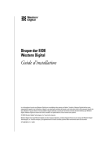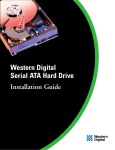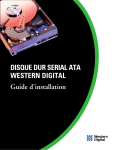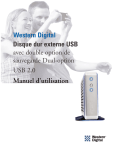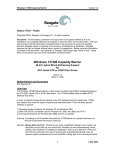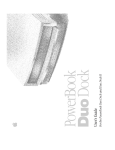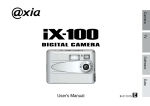Download Apple ATA Hard Drive Install guide
Transcript
® EIDE Hard Drive Quick Install Guide Internal Desktop WD Caviar SE This document was designed to aid in the quick installation of your new WD EIDE hard drive. For further information regarding the installation and use of your drive, visit our website at support.wdc.com. Kit Contents Compatibility Operating System Information Windows® XP (SP 1 or higher needed for drives >137 GB) Windows 2000 (SP 3 or higher needed for drives >137 GB) Windows Me and Windows 98SE (may require an Ultra ATA controller card) Mac® OS X v10.2 or later requires a Mac-compatible ATA controller card (for drives larger than 137 GB) Installing Your New WD Hard Drive as an Upgrade From a Previously Installed Hard Drive To ensure the optimal settings for your drive configuration, we recommend you run the Installation Tutorial in the Windows version of Data Lifeguard Tools™ prior to the hardware installation. Data Lifeguard Tools for Windows will generate your custom installation instructions based on the configuration you choose. For more information on using Data Lifeguard Tools, visit our website at support.wdc.com. Note: Compatibility may vary depending on user’s hardware configuration and operating system. WD Hard Drive Unpacking & Drive Handling Information Utilities and software CD Documentation WD hard drives are precision instruments and should be handled with care during unpacking and installation. Hard drives can be damaged by rough handling, shock and vibration, or electrostatic discharge (ESD). Be aware of the following precautions: • This product contains no user-serviceable parts; refer servicing to WD authorized personnel only. • Do not unpack your hard drive until you are ready to install it. Your hard drive is packaged in an anti-static bag. • To avoid ESD problems, ground yourself by touching the metal chassis of the computer before handling the hard drive. Articles of clothing generate static electricity. Do not allow clothing to come in direct contact with the hard drive or circuit board components. • Handle the hard drive by its sides only. Avoid touching the circuit board components on the bottom of the hard drive. • Do not drop, shake, or knock down the hard drive. • Do not stack hard drives or stand your WD hard drive on its edge. 1. Before Getting Started Mounting Screws and Jumper Shunt 1. Gather these materials and tools: WD hard drive kit; standard 40-pin, 80-conductor cable; computer system manual; operating system manual and installation diskette/CD; Phillips and flat-blade screwdrivers. 2. Before performing any hardware installation, back up your existing data. 3. Before handling the hard drive or any other components, discharge static electricity by touching the metal chassis of your computer or by using an anti-static wrist strap. 4. Record your WD hard drive serial number, model number, and date code. 5. Power off the computer and unplug the power cord. 6. Remove the system cover (refer to your system manual for instructions). -1- Windows XP (Service Pack 1 or higher) and 2000 (Service Pack 3 or higher) If you are running one of these operating systems, run the Data Lifeguard Tools Installation Tutorial, carefully following the on-screen instructions to set up your larger than 137 GB hard drive without a controller card. Windows 98SE and Windows Me If your system does not support 48-bit Logical Block Addressing (LBA), WD recommends installing an Ultra ATA controller card to access the full capacity of your hard drive greater than 137 GB. Make sure that your system BIOS supports the card and that its drivers have been properly installed prior to connecting the hard drive. You can purchase an Ultra ATA/100 PCI controller card at the WD Online store at store.wdc.com (U.S.A. only) or your local computer retailer. For more information, visit our website at support.wdc.com. Alternate Solution Intel® offers drivers for certain chipsets which provide BIOS support for the full capacity of drives larger than 137 GB. Contact your motherboard or system manufacturer for compatibility and installation instructions. EN 2. Set the Jumpers Figure 1 WD EIDE hard drives have a 10-pin jumper block located next to the 40-pin IDE connector on the hard drive. Jumper the drive according to your desired configuration (i.e., Cable Select, Master/Slave, or Single). Refer to the illustration on the left (Figure 1) for reference. A. Cable Select Cable Select is the default setting for WD EIDE hard drives and requires a standard 40-pin, 80-conductor cable (not included). If your system supports Cable Select, there is no need to reposition the jumper shunt on the drive. If you are installing your new WD hard drive with an existing IDE drive on the cable, make sure that the other drive is also jumpered as Cable Select. If your system does not support Cable Select or if you are uncertain, use the Single or Master/Slave configuration. 40-pin IDE connector Jumper block Jumper shunt Power supply connector Single Cable Select (Default Setting) Dual (Master) Dual (Slave) Note: Cable Select mode is not supported by Macintosh’s built-in IDE/ATA controller. You must use the Master/Slave jumper setting. B. Standard Jumper Settings (Master/Slave or Single Configuration) 1. If installing your new WD hard drive as the only device on the cable, use the Single setting (no jumper shunt required). 2. If installing your new WD hard drive as the Master device on the cable with two IDE drives, use the Master setting. 3. If installing your new WD hard drive as a secondary device on the cable, use the Slave setting. Figure 2 Gray 40-pin connector Black 40-pin connector Blue 40-pin connector SYSTEM SECONDARY DRIVE (SLAVE) 3. Install the Hard Drive PRIMARY DRIVE (MASTER) Important: Your new WD hard drive must be installed using a standard 40-pin, 80-conductor IDE interface cable. Figure 3 Note: Installation instructions will vary depending on your drive configuration. Carefully follow the appropriate procedure that corresponds to your drive configuration. Pin 1 Motherboard Interface cable from hard drive 1. If installing the hard drive as the only device on the cable, connect the black connector of the IDE interface cable to the drive and the blue end of the cable to the IDE connector on the motherboard. Proceed to step 3. 2. If installing two drives on the same IDE cable, a. Jumper the bootable drive as Master and the other drive as Slave; then connect the Master drive to the black connector of the IDE interface cable and the Slave drive to the gray connector. b. Connect the blue end of the IDE interface cable to the IDE connector on the motherboard (Figure 2). 3. Attach the power supply cable to the 4-pin power connector on the drive (Figure 3). 4. Slide the hard drive into an available 3.5-inch drive bay and secure the drive with the four mounting screws provided (two on each side). For proper grounding, use screws in the hole positions as shown (Figure 4). 5. Verify all cable connections. Replace and secure the system cover. Reconnect the power cord and power on the computer. IDE interface cable Power connector Power supply cable Figure 4 Mounting frame -2- 4. Set Up the Hard Drive Installation Instructions for Macintosh Systems To assist with your installation, WD provides a set of hard drive utilities called Data Lifeguard Tools with versions available for both Windows and DOS. For further information, visit our website at support.wdc.com. You can install two IDE/ATA hard drives on the same cable with the Master/Slave jumper configuration in the following Macintosh systems: • Power Mac G4 and higher • Power Mac G3 (blue and white colored, limited to certain configurations) • Power Mac G3 all-in-one Figure 5 A Power Mac with a U-shaped mounting bracket installed in the rear drive bay is capable of supporting dual IDE/ATA drives, allowing two drives to be installed in that bay. For more information on Master/Slave support on Power Macs G3/G4, refer to Apple support article 24342 at www.apple.com/support. Important: For detailed setup and installation instructions specific to your Macintosh system, refer to your original Apple Setup Guide or go to www.apple.com/support. You can install your new WD hard drive according to one of the following system configurations: a. If your system does not support the Master/Slave configuration, you will be limited to installing one IDE/ATA device per channel for a maximum of two IDE/ATA devices. b. To install a drive greater than 137 GB, you must install a Macintoshcompatible Ultra ATA/100 controller card. Follow the instructions that came with your card to make sure that the Ultra ATA drivers have been properly installed prior to connecting the hard drive. c. To install a hard drive smaller than 137 GB as an additional hard drive in a Power Mac, change the configuration to Slave (see page 2 for a diagram of the jumper block). The drive that came with the Macintosh is already designated as Master (Master ID=0, Slave ID=1). To mount the hard drive in your Macintosh, follow the instructions from your Apple Setup Guide. Windows 2000 or XP: For advanced users, see “Alternate Setup” below. Windows 98SE or Me: If your hard drive is larger than 137 GB, you will need to use the DOS version of Data Lifeguard Tools to maximize the full capacity of your drive. 1. Insert the Data Lifeguard Tools CD into the CD-ROM drive. 2. Autorun the CD to use the Windows version (Figure 5) or boot your system to the CD for the DOS version. If unable to boot to CD, boot from the Data Lifeguard Tools diskette. Execute the Diskette Creator program on the Data Lifeguard Tools CD to create the diskette. 3. The software will scan and detect the newly installed hard drive. Click Yes to set up the new hard drive. 4. Set up your new hard drive by carefully following the on-screen instructions. Select the Advanced Installation or Custom Partition option to create partitions during setup. 5. Remove the Data Lifeguard Tools CD and reboot the system. Note: Cable Select mode is not supported by Macintosh’s built-in IDE/ATA controller. You must use the Master/Slave jumper setting. At the end of the program, Data Lifeguard Tools will indicate a successful setup or provide further details. This concludes the hard drive installation process. Alternate Setup Instructions for Windows 2000/XP Install a Single Hard Drive: 1. Boot to the Windows 2000/XP Installation CD. 2. Follow the directions in the installation prompt. Install an Additional Hard Drive in Windows: 1. Click the Start button and point to Settings > Control Panel > Administrative Tools. 2. Double-click on the Computer Management icon and select Disk Management on the left side. 3. Right-click on your new hard drive to proceed with partitioning and formatting. -3- Troubleshooting 32 GB Barrier Some BIOSs released before June 1999 stall with drives larger than 32 GB. If you are installing such a hard drive and your system stalls before floppy or hard drive boot can take place, your system BIOS may be incompatible with this drive. Follow these instructions only if your system stalls when adding a drive larger than 32 GB. If after carefully following the installation instructions you experience difficulties, read this section for suggestions for possible solutions or visit our website at support.wdc.com for a complete list of frequently asked questions before contacting WD Technical Support. Operating System and BIOS Limitations Operating systems and system BIOSs have separate limitations that are related to specific hard drive capacities that affect how your hard drive will be supported. Verify that your system BIOS supports your new hard drive. For further information regarding operating system and BIOS limitations, visit our website at support.wdc.com or visit Microsoft® at support.microsoft.com. Recommended Solution: Obtain a BIOS upgrade from your system or motherboard manufacturer. Interim Solution: 1. Jumper the hard drive to your desired configuration per the instructions in section 2 of this guide. 2. Use the Data Lifeguard Tools software to access full hard drive capacity. To run Data Lifeguard Tools: a. Boot from the Data Lifeguard Tools CD. b. Follow the setup instructions for your hard drive. 137 GB Barrier The previous standard for the IDE/ATA interface uses 28-bit addressing, which cannot recognize more than 137.4 GB of storage. To overcome this capacity barrier, hard drives higher than this capacity have adopted a 48-bit addressing system which can be supported in newer computer systems with updated controller chips, BIOS codes, and operating system service packs. Operating System Windows Millennium • Windows 98SE and Me require the use of a 48-bit LBA supported controller card to fully recognize higher capacity hard drives. • Windows 2000 and XP users can now update their operating system with the latest Service Packs (SP) from Microsoft and with the latest version of Data Lifeguard Tools software, drives larger than 137 GB can be accessed to the full capacity. • Certain operating system utilities such as ScanDisk and Defrag may not function properly on drive partitions exceeding 137 GB. Creating multiple partitions less than 137 GB will allow proper functionality. May exhibit the following problems Microsoft Knowledge Base Article ID# FORMAT displays the size of partitions or logical drives larger than 64 GB incorrectly Q263045 Windows 98 • FDISK does not recognize the full size (all versions) of hard drives larger than 64 GB • FORMAT displays the size of partitions or logical drives larger than 64 GB incorrectly • ScanDisk reports errors on hard drives larger than 32 GB Q263044 Q263045 Q263050 Windows 95 Does not support hard drive capacities (all versions) greater than 32 GB; upgrade to Windows XP or Windows 2000. Not available Alternate Jumper Settings Some older computer systems have difficulty detecting large capacity hard drives. If your system locks up after the installation of your new hard drive, try an alternate jumper setting to resolve this issue. For detailed information on alternate jumper settings, visit our website at support.wdc.com. Figure 6 Single If the drive you are installing is the only device on the cable, use this setting. 10-pin connector Dual (Master) If the drive you are installing is the Master on the cable with two IDE devices, use this setting. 10-pin connector Dual (Slave) If the drive you are installing is the Slave on the cable with another hard drive, use this setting. 10-pin connector -4- Technical Support Radio Frequency Interference Statement If you need additional information or help during the installation or normal use of this product, visit our product support website at support.wdc.com. FCC Notice This WD product has been verified to comply with the limits for a Class B computing device pursuant to Part 15, Subpart B of FCC rules. This does not guarantee that interference will not occur in individual installations. WD is not responsible for any television, radio, or other interference caused by unauthorized modifications to this product. Online Product Registration Take advantage of various WD offerings by registering your hard drive online at: register.wdc.com If interference problems do occur, consult the system equipment owner's manual for suggestions. These suggestions may include relocation of the computer system away from the television or radio, or placing the computer AC power connection on a different circuit or outlet. Regulatory Compliance This appendix contains information on the following topics: • Agency Approvals • Radio Frequency Interference Statement • Warranty Information CSA Notice Le prent appareil numérique n'émet pas de bruits radioélectriques dépassant les limites applicables aux appareils numériques de la classe B préscrites dans le Règlement sur le brouillage radioélectrique édicté par le ministère des Communications du Canada. Agency Approvals WD hard drives meet the standards of the following regulatory agencies: Federal Communication Commission (FCC) Verified to comply with FCC Rules for Radiated and Conducted Emission, Part 15, Subpart B, for Class B Equipment. This digital apparatus does not exceed the Class B limits for radio noise for digital apparatus set out in the Radio Interference Regulations of the Canadian Department of Communications. Underwriters Laboratories (UL) UL-Standard 1950, Standard for Safety of Information Technology Equipment including Electrical Business Equipment (File E101559). Canadian Standards Association (CSA) CSA-Standard C22.2, No. 950-M89, Standard for Safety of Information Technology Equipment including Electrical Business Equipment (File LR68850). TUV Essen Laboratories IEC-950 (EN60950) Standard for Safety of Information Technology Equipment including Electrical Business Equipment. CE Compliance for Europe Verified to comply with EN55022:1998 for RF Emissions and EN55024:1998 for Generic Immunity as applicable. -5- Warranty Information Your Use of the Product WD will have no liability for any Product returned if WD determines that: • The product was stolen from WD. • The asserted defect: a. is not present, b. cannot reasonably be fixed because of damage occurring when the Product was in the possession of someone other than WD, or c. is attributable to misuse, improper installation, alteration (including removing or obliterating labels), accident or mishandling while in the possession of someone other than WD. • The Product was not sold to you as new. Obtaining Warranty Service Western Digital (WD) values your business and always strives to provide you the very best of service. No limited warranty is provided by WD unless your WD Product (Product) was purchased from an authorized distributor or authorized reseller. Distributors may sell Products to resellers who then sell Products to end users. See below for warranty information or obtaining service. No warranty service is provided unless the Product is returned to an authorized return center in the region (Americas, Europe-Middle East-Africa, or Asia Pacific) where the Product was first shipped by WD. Limitation of Remedies Your exclusive remedy for any defective Product is limited to the repair or replacement of the defective Product. WD may elect which remedy or combination of remedies to provide in its sole discretion. WD shall have a reasonable time after determining that a defective Product exists to repair or replace a defective Product. WD's replacement Product under its limited warranty will be manufactured from new and serviceable used parts. WD's warranty applies to repaired or replaced Products for the balance of the applicable period of the original warranty or ninety days from the date of shipment of a repaired or replaced Product, whichever is longer. Important: If your Product was originally purchased as a component integrated within a system by a system manufacturer, no limited warranty is provided by WD. Contact the place of purchase or the system manufacturer directly for warranty service. Return Material Authorization No Product may be returned directly to WD without first contacting WD for a Return Material Authorization (RMA) number. An RMA number may be obtained from our online support website at support.wdc.com. An unauthorized return, i.e. one for which an RMA number has not been issued, will be returned to you at your expense. Authorized returns are to be shipped pre-paid and insured to the address on the RMA in an approved shipping container. Your original box and packaging materials should be kept for storing or shipping your Product. For information on approved shipping containers, visit our product support website at support.wdc.com. Limitation of Damages WD's entire liability for any defective Product shall in no event exceed the purchase price for the defective Product. This limitation applies even if WD cannot or does not repair or replace any defective Product and your exclusive remedy fails of its essential purpose. Limited Warranty WD's limited warranty provides that, subject to the following limitations, each Product will be free from defects in material and workmanship and will conform to WD's specification for the particular Product. No Consequential or Other Damages WD has no liability for general, consequential, incidental or special damages. These include loss of recorded data, the cost of recovery of lost data, lost profits and the cost of the installation or removal of any Products, the installation of replacement Products, and any inspection, testing, or redesign caused by any defect or by the repair or replacement of products arising from a defect in any Product. In the United States, some states do not allow exclusion or limitation of incidental or consequential damages, so the limitations above may not apply to you. This warranty gives you specific legal rights, and you may also have other rights which vary from state to state. Duration of Warranty The warranty period commences from the date of manufacture appearing on the Product label of the original Product purchase. To verify this period for your Product, visit product support website at support.wdc.com. In the United States, some states do not allow limitations on how long implied warranties last, so the above limitation may not apply to you. Other Warranty Limitations For further important information on limitations on WD's warranty, see below or visit our product support website at support.wdc.com and click on Warranty Policy. Online Warranty Inquiry For further warranty information and inquiries, visit our product support website at support.wdc.com and click on Warranty Policy. The new online Warranty Inquiry System will provide warranty status based on the serial number of the Product. Disclaimer of Warranties There are no warranties which extend beyond the face of the WD limited warranty. WD disclaims all other warranties, expressed or implied, regarding the Products, including any implied warranties of merchantability, fitness for a particular purpose or noninfringement. In the United States, some laws do not allow the exclusion of the implied warranties. Extended Warranty Certain WD products may be eligible for purchase of additional or extended warranty options. For further details, visit our product support website at support.wdc.com and click on Warranty Policy. Western Digital and WD are registered trademarks; and the WD logo, Data Lifeguard, and Data Lifeguard Tools are trademarks of Western Digital Technologies, Inc. Other marks may be mentioned herein that belong to other companies. Western Digital reserves the right to change specifications at any time without notice. © 2006 Western Digital Technologies, Inc. All rights reserved. 2079-001026-213 Aug 2006 -6-







